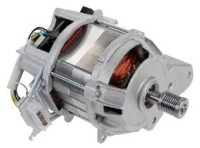Controller for Household Appliance Motors - Request for Comments

We want to start a project to develop a controller for motors scavenged from washing machines and similar household appliances. Several people have requested such a project, so it seems to be a popular subject.
We want to start a project to develop a controller for motors scavenged from washing machines and similar household appliances. Several people have requested such a project, so it seems to be a popular subject.
In order to come up with the best solution we would like to know what you expect from such a driver. If you have ideas, requests or a wishlist for such a project, please post a contribution or send an email to labs at elektor dot com
Thank you for your participation!




Discussion (7 comments)
Andreas72AB 9 years ago
some years ago I improved the drive unit of a knitting machine. There is a series motor that was driven by a simple triac circuit at the mains supply with a potentiometer in a pedal. The circuit is almost the same as in a sewing machine, but at the knitting machine the load varies more. With load the motor was slowing down. I replaced this circuit by a circuit with an Atmel U2008B. I selected this IC because it stabilises the speed just by sensing the current and it can drive a triac directly. The U2008B is easy to use. Now the motor is still getting slower at load, this must be because of the principle of the U2008B, but it is not as bad as it was before.
Meanwhile the U2008B is discontinued. So my wish for a wishlist is a circuit with speed stabilisation, soft start and that is easy to use.
Interesting: There is a rectifier between the triac circuit and the motor so the motor runs with DC instead of AC, perhaps for lower core loss.
I hope you understand my German accent, viele Grüße aus Alzenau!
Serge.Ambazian 10 years ago
Before the opening of our washing machine to fix some problems of excessive noise, I thought that it was powered by an induction motor whith a variable frequency inverter.
Not at all (maybe in the very expensive ones ...), it is a simple DC motor with collector and brushes.
It is easy to power that kind of motor.
If you only want to vary the speed you need only a diode and a transistor, very easy to build.
If you want also forward/reverse you can use a full-bridge or half-bridge chopper.
petrus bitbyter 10 years ago
Several types of motors can be used in household appliances.
Serial motors are usual in things like drills and vacuum cleaners. When AC-powered the speed is controlled by phase control most of the times. If memory serves they are best controlled while DC powered using PWM, as ever described in an Elektor article.
Washing - and similar machines usually are equipped with squirrel cage motors. The real three phase types are best controlled using a (one to) three phase frequency inverter as - again - ever described in an Elektor article. As the article is pretty old, some components used at the time may not be available anymore and the progress made in microcontrollers, a redesign may be interesting.
FAIK most of the sqirrel cage motors in household appliances are single phase types using an extra coil and/or a capacitor to simulate three phases. As one may expect they are optimized for 50Hz or 60Hz. Frequency control can have unexpected and unwanted effects. For example, some of that motors use an extra startup coil that is switched off when the motor is up to its nominal speed. When kept below the switchoff speed, the startup coil will be fried.
So what type of motor are we talking about?
Even more interesting: What to use it for?
petrus bitbyter
EN114576 10 years ago
a good project would be:
a practical speed controller for white good motors to provide electric drive on a boat. 48 volts DC input with either voltage step up or modification of the motor windings to operate at the lower value.
or a turntable drive for automatic tracking of the sun with solar heating panels.
m.a.c 10 years ago
I have a IRAMS10UP60B IRF and began to develop a frequency converter, based on a PIC microcontroller, to a three-phase 220V motor for automatic gate. I had some doubts about how to develop a routine v / f so I have not finished this project. I believe that this integrated circuit can be harnessed to the proposal in question and help me continue with my initial project.
Follow the link to the datasheet of this component:
http://www.irf.com/product-info/datasheets/data/irams10up60b.pdf
irams10up60b-circuits.jpg (64kb)
petrus bitbyter 10 years ago
plux 10 years ago
three-phase 230 / 380 voltage
The most important parameters for Frequency inverters
Minimum output frequency
Maximum output frequency
Acceleration time main setpoint
Deceleration time main setpoint
JOG1, JOG2, JOG3
V/f-rated frequency
Slip compensation
DC-injection brake
I Max motor mode
I Max generator mode
Offset analog input
Gain analog input
Digital Inputs to control:
CW rotation, CCW rotation
DCB DC-injection brake
Jog1 Jog2 Jog3 Selection of fixed setpoints
Quick stop
etc.
Digital outputs:
Drive is Ready, Motor is running, etc.
Analog input to control drive speed
Analog output = actual speed of the motor
sal 10 years ago
I have a motor from a washing machine that failed due to a problem not related to the motor. If a controller were available,the motor would make a perfect replacment for my drill press. It would require a controller that has a slngle phase input and a three phase output with a variable frequency for speed control.
Such controllers are available commercially but the cost would not make the change viable
petrus bitbyter 10 years ago